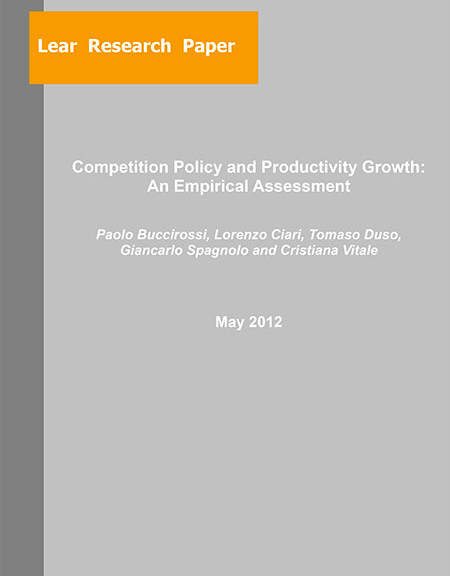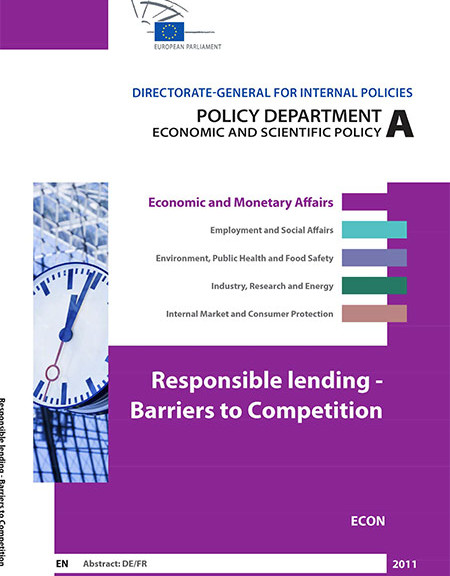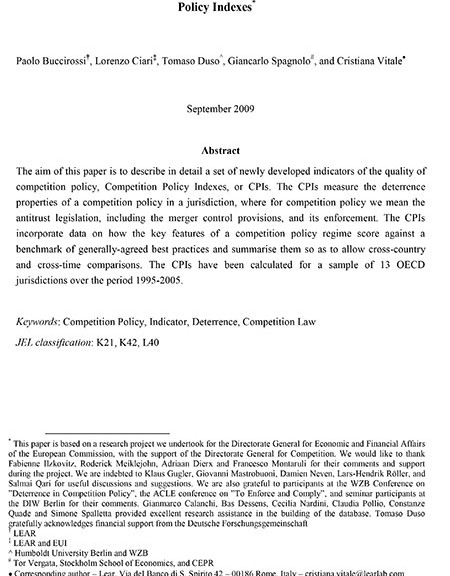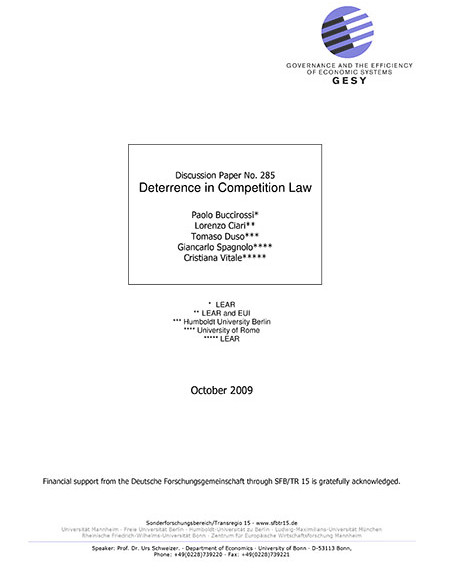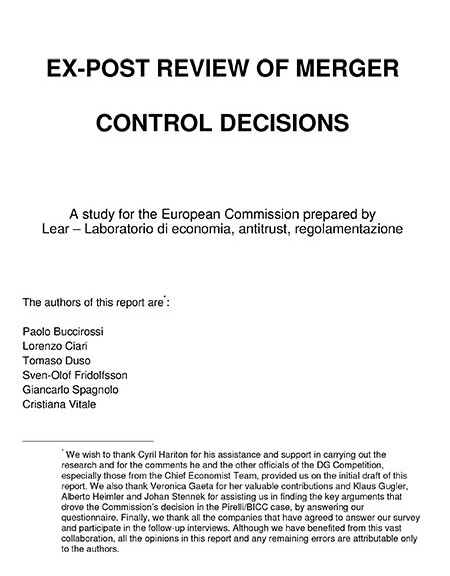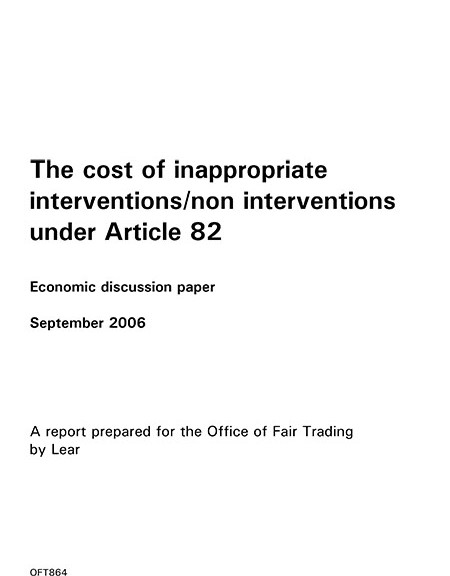The report empirically investigates the causal effects of three decisions adopted by the European Commission on the performance of telecoms markets, namely the T-Mobile/Orange merger in the UK mobile markets, a state aid decision in the German fixed broadband market and an abuse of dominant position by Telekomunikacja Polska in the Polish fixed market. The report also provides a descriptive analysis on the evolution of competition policy enforcement in the telecoms markets and the concurrent trends in markets’ performance.
Archives
Competition policy and productivity growth: an empirical assessment
This paper empirically investigates the effectiveness of Competition Policy by estimatingits impact on Total Factor Productivity (TFP) growth for 22 industries in 12 OECD countries over the period 1995-2005. Using country-industry and time fixed effects, and controlling for most other determinants of productivity growth, we find a robust positiveand significant effect of competition policy as measured by newly created indexes on TFPgrowth. We provide several arguments and results based on instrumental variables estimators as well as non-linearities, to support the claim that the established link can be interpret in a causal way. At a disaggregated level, the effect on TFP growth is particularly strong for specific aspects of competition policy related to its institutional set up and antitrust activities(rather than merger control). The effect is further strengthened by a low cost of contract enforcement, suggesting institutional complementarities between competition policy and the efficiency of law enforcement institutions.
Responsible Lending – Barriers to Competition
This study analyses the main barriers to effective competition in the provision of mortgage credit. The study considers and discusses barriers affecting both the supply (distance, information sharing, cross-selling practices, linkages between mortgage lenders and other market players) and the demand (switching and search costs) side of the market. Based on the available evidence it provides an assessment of the extent to which such barriers restrict competition in the mortgage market.
Study commissioned by the European Parliament
Measuring the deterrence properties of competition policy: the competition policy indexes
This article describes in detail a set of newly developed indicators of the quality of competition policy, the Competition Policy Indexes (CPIs). The CPIs measure the deterrence properties of a jurisdiction’s competition policy—where by competition policy, we mean the antitrust legislation including the merger control provisions and its enforcement. The CPIs incorporate data on how the key features of a competition policy regime (particularly information on the legal framework, the institutional settings, and the enforcement tools of each jurisdiction that we examine) score against a benchmark of generally agreed-upon best practices and summarize them, so as to allow cross-country and cross-time comparisons. We calculate the CPIs for a sample of 13 OECD jurisdictions over the period from 1995 to 2005.
Forthcoming in the Journal of Competition Law & Economics (working version downloadable)
Deterrence in Competition Law
This paper provides a comprehensive discussion of the deterrence properties of a competition policy regime. On the basis of the economic theory of law enforcement we identify several factors that are likely to affect its degree of deterrence: 1) sanctions and damages; 2) financial and human resources; 3) powers during the investigation; 4) quality of the law; 5) separation of power. We then discuss how to measure deterrence. We review independence and 6) the literature that uses surveys to solicit direct information on changes in the behavior of firms due to the threats posed by the enforcement of antitrust rules, and the literature based on the analysis of hard data. We finally argue that the most challenging task, both theoretically and empirically, is how to distinguish between “good” deterrence and “bad” deterrence.
Gesy- Discussion Paper n.285
Ex post review of merger control decisions
In this study prepared for the European Commission Lear proposes a methodology for the ex-post assessment of merger control decisions. The aim of the methodology is to establish whether the market structure arising from the decision protects social welfare better than the market structures that could have arisen from alternative decisions. The methodology also assesses whether the underlying economic analysis is correct and complete. The study then applies the proposed approach to the EU decision on the Pirelli and BICC merger.
Published by the European Commission (February 2007)
The cost of inappropriate interventions/non interventions under Article 82
The object of this research produced by the UK Office of Fair Trading (OFT) from LEAR is to improve the understanding of the costs of inappropriate competition authority (non) intervention in cases relating to abuse of dominance. A key aim is a greater understanding of these ‘error costs’ by type of abuse, industry characteristics and form of competition. The research proposes a new taxonomy of potentially abusive conducts and discusses how to asses their welfare effects, so as to minimize the costs of the errors which could be committed by a competition authority.
Published by the OFT (September 2006)
A Search Model Where Consumers Choose Quantity Based on Expected Price
I describe a price game in which consumers face search costs and base their quantity decision on the expected price. Because of search costs, the choice of the firm they will buy from is described by a random process. I show that the expected equilibrium price is above the monopoly price. This result does not change if demand comes from a small share of perfectly informed consumers with zero search costs.
Published in The Journal of Industrial Economics, December 2003, Vol. LI, n. 4, pp. 427-32.
Competition Policy and the Agribusiness Sector in the European Union
This paper analyses the main antitrust decisions in the agribusiness sector in Europe. First, legislation and economic principles are recalled. Then for input suppliers, farmers, manufacturers, and retailers, we give a brief presentation of the market structure and discuss the main competition concerns according to the most recent antitrust decisions. Farmers are the weakest link of the entire chain, given the degree of concentration in the upstream and downstream industries in Europe. The use of the concept of buying power could be developed by competition authorities to balance power along the agro-food chain.
Published in European Review of Agricultural Economics, 29(3), August 2002, pp. 373-397.


